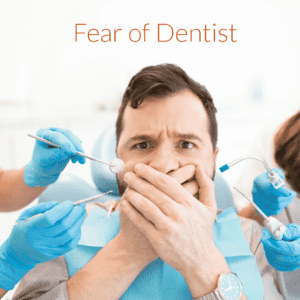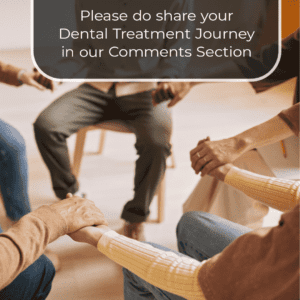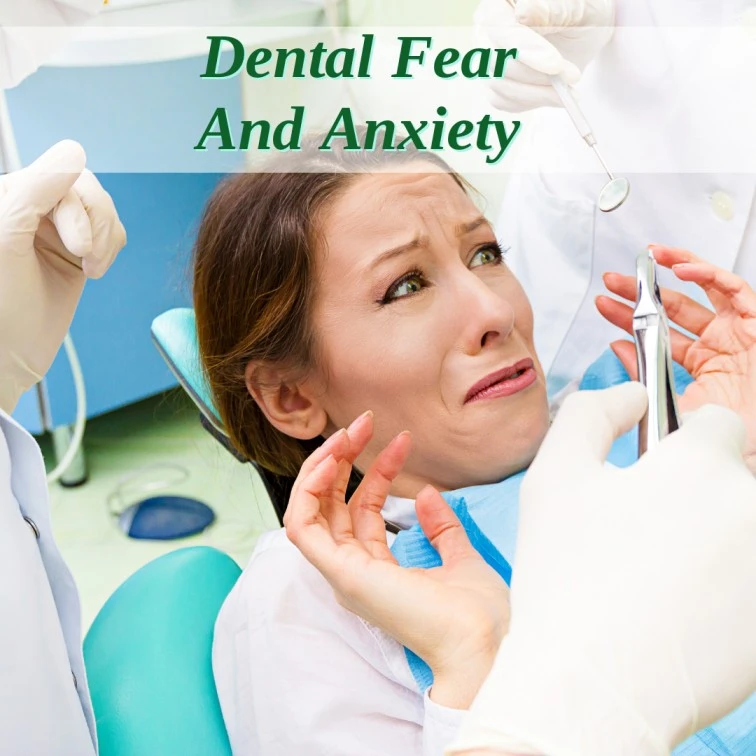Last updated on September 21st, 2023 at 08:10 pm
Introduction
Addressing dental fear and anxiety is not just about enhancing the patient experience; it’s a vital aspect of maintaining oral health.
Dental fear and anxiety is an emotional response characterized by apprehension or fear related to dental procedures and treatments.
It’s not uncommon for individuals to experience a level of nervousness before appointments, but when this dental fear and anxiety becomes overwhelming and interferes with oral health care, it can be classified as dental anxiety.
This anxiety can range from mild unease to extreme fear, and it often stems from a variety of factors such as past traumatic experiences, fear of pain, or a feeling of loss of control.
When fear of dental treatment prevent individuals from seeking dental care, their oral health can deteriorate, leading to more significant problems over time.
Table of Contents
Prevalence of Dental Fear
Anxiety is more widespread than many might realize, affecting a significant portion of the population.
The prevalence of dental fear varies significantly across studies.
For instance, Dutch adults had a dental fear prevalence of 24.3%, over 16.1% of Australians aged 5 and above reported experiencing high levels of dental fear and among Japanese university students, the range of extreme dental fear was found to be between 6% and 14%.
Some studies indicate that around 30-40% of adults experience some level of dental fear and anxiety, with approximately 10% suffering from dental phobia.

Importance of Addressing Fear of Dentist for Overall Well-Being
Dental health is intricately linked to general health, with gum disease being associated with conditions like cardiovascular disease, diabetes, and respiratory issues.
Moreover, the fear and anxiety related to dental visits can have a negative impact on mental health, leading to increased stress levels and avoiding social situations due to embarrassment about oral health.
It’s important to recognize that each person’s experience with dental anxiety is unique, and the journey towards overcoming it requires personalized strategies and support.
Differentiating between Fear and Anxiety
Dental fear and anxiety are often used interchangeably, but they have distinct characteristics.
Fear is an emotional response to an immediate threat or danger, such as the fear of pain during a dental procedure. It’s a rational reaction to a real or perceived risk, and it can lead to a “fight or flight” response.
On the other hand, anxiety is a more generalized and long-lasting emotional state. Dental anxiety involves a persistent feeling of unease, worry, and apprehension about upcoming dental visits or procedures.
Unlike fear, anxiety is not always tied to a specific threat and can be triggered by the thought of a dental appointment, even if it’s far in the future.
Common Triggers and Causes of Dental Fear and Anxiety
Understanding the triggers and causes of dental fear is crucial for addressing and managing this issue effectively. Common triggers include:
- Pain and Discomfort: Past painful experiences can lead to fear of experiencing pain again, causing individuals to associate dental visits with discomfort.
- Needles and Injections: Fear of needles is a prevalent trigger, as injections are often part of dental procedures.
- Loss of Control: Feeling helpless or not in control during a dental procedure can contribute to anxiety.
- Negative Past Experiences: A traumatic or negative experience in the past can create lasting anxiety about future dental visits.
- Sounds and Smells: The unfamiliar sounds and smells in a dental office can heighten anxiety, especially for those with sensory sensitivities.
- Embarrassment: Some individuals may feel embarrassed about the condition of their teeth, leading to avoidance of dental visits.
- Media Depictions: Movies, television shows, and stories portraying dental procedures negatively can shape perceptions and fuel anxiety.
Strategies to Manage Dental Fear and Anxiety
A. Communication: Building Trust between Patient and Dentist
Effective communication is a cornerstone in managing dental fear and anxiety, fostering trust between patients and dental professionals.
Importance of Open Dialogue:
Establishing a comfortable environment where patients feel heard and understood is paramount.
Dentists should encourage patients to express their concerns, fears, and past negative experiences openly.
This creates an opportunity for dentists to address specific worries and tailor treatments accordingly.
Discussing Treatment Options and Procedures in Detail:
Transparently explaining procedures and treatment options helps demystify the dental experience.
When patients are informed about what to expect, they can mentally prepare and feel more in control. Dentists should use plain language, visual aids, and take time to answer questions, ensuring patients fully comprehend the process.
B. Relaxation Techniques: Easing the Mind and Body
Relaxation techniques can mitigate anxiety by promoting a sense of calm and control.
Deep Breathing Exercises:
Deep, slow breathing helps activate the body’s relaxation response, reducing stress and anxiety.
Encourage patients to practice deep breathing before and during appointments to alleviate tension.
Guided Imagery and Visualization:
Guided imagery involves creating positive mental images to counteract anxious thoughts.
Dentists can guide patients through relaxing scenarios, diverting their focus from the dental setting.
Visualization techniques can help patients associate the dental office with tranquility rather than fear.
C. Sedation Dentistry: Options for a Comfortable Experience
Sedation dentistry offers varying levels of sedation to help patients relax during procedures.
Exploring Different Levels of Sedation:
Dentists can offer different sedation options based on the patient’s anxiety level and the complexity of the procedure.
These include nitrous oxide (laughing gas), oral sedatives, and intravenous (IV) sedation.
Tailoring the sedation level ensures patients are comfortable while remaining conscious and responsive.
Benefits and Considerations:
While sedation can ease anxiety, it’s essential for patients to understand the benefits and potential side effects.
Dentists should discuss how sedation works, its effects, and the recovery process.
Informing patients about the monitoring and safety measures in place during sedation instills confidence in their well-being.
D. Cognitive Behavioral Therapy (CBT): Rewiring Negative Thought Patterns
CBT is a powerful psychological approach that helps patients reframe anxious thoughts and behaviors.
Identifying Irrational Fears:
Dentists trained in CBT can identify specific triggers and thought patterns contributing to dental anxiety.
Collaborating with patients to identify these irrational fears is the first step toward addressing them.
Techniques to Reframe Anxious Thoughts:
CBT techniques include cognitive restructuring, which involves challenging and changing negative thought patterns.
Patients learn to replace fear-driven thoughts with rational, balanced perspectives.
Gradual exposure to dental experiences combined with these techniques helps desensitize patients to anxiety triggers.
Building a Patient Friendly Dental Clinic
Designing Calming Dental Spaces
Creating a soothing and inviting atmosphere in the dental office is pivotal in alleviating patient anxiety.
Incorporating Soothing Elements in the Dental Office:
Strategically integrating calming elements like soft lighting, nature-inspired décor, and relaxing colors can help reduce stress.
Water features, aromatherapy, and comfortable furniture contribute to a serene environment, diminishing the clinical feel of the space.
The Role of Visual Aesthetics in Reducing Anxiety:
Visual cues play a significant role in shaping the patient experience.
Artwork and visuals that evoke positive emotions can distract from dental procedures and redirect attention.
Nature scenes, abstract art, and soothing images can engage patients’ minds, easing their anxiety.
Empathetic Dental Care: The Role of Professionals
Dental professionals have a profound impact on shaping patients’ perceptions and easing their anxiety.
Compassionate Dentists and Staff:
Empathy and understanding from dental professionals can foster a sense of safety and trust.
Dentists who acknowledge patients’ fears and actively work to address them create a supportive environment. A
dditionally, a friendly and patient-centered approach from the dental staff contributes to a positive experience.
Importance of Personalized Care Plans:
Recognizing that each patient is unique is crucial. Dentists should craft personalized care plans that consider individual fears, triggers, and preferences.
By involving patients in decision-making and addressing their concerns, dental professionals can ensure a more comfortable and less anxiety-inducing experience.
Latest equipment you must have in your dental clinic.
Exploring the Psychological and Physiological Aspects
Psychological Aspects: Dental anxiety is often rooted in psychological factors, such as:
- Anticipatory Anxiety: The anxiety experienced before a dental appointment can be more distressing than the procedure itself.
- Cognitive Distortions: Negative thought patterns and irrational beliefs about dental visits can amplify anxiety.
- Conditioning: Associating dental visits with negative experiences can condition individuals to automatically feel anxious.
- Control and Trust: A lack of control over the situation and trust in the dentist’s abilities can heighten anxiety.
Physiological Aspects: Dental anxiety also has physiological manifestations, including:
- Increased Heart Rate: The body’s “fight or flight” response triggers an elevated heart rate, preparing for perceived danger.
- Muscle Tension: Anxiety can lead to muscle tension, especially in the jaw and neck, contributing to discomfort.
- Nausea and Dizziness: Some individuals experience feelings of nausea and dizziness due to heightened anxiety.
- Sweating and Shaking: Profuse sweating and trembling are common physical responses to anxiety.
Overcoming Dental Anxiety: Real Stories
Story 1: Finding Comfort in Communication
Rita (name changed) had always been terrified of dental visits due to a childhood experience.
However, she decided to confront her fear and scheduled an appointment with a new dentist. During her visit, she expressed her anxiety to the dentist.
To her surprise, the dentist patiently listened, explained each step of the procedure, and provided breaks whenever she felt overwhelmed.
This compassionate approach helped Rita feel more at ease. With open communication, understanding, and the dentist’s willingness to accommodate her needs, she successfully managed her dental anxiety and now visits the dentist regularly.
Story 2: Conquering Fear with Sedation Dentistry
Sara’s dental anxiety had prevented her from seeking dental care for years.
Her teeth were deteriorating, and she knew she needed help. Upon consulting a dentist, Sara was introduced to sedation dentistry.
Her dentist explained the different levels of sedation and discussed the benefits.
With the support of sedation dentistry, Sara completed multiple treatments painlessly. The positive experiences gradually reduced her anxiety, and she now visits the dentist regularly for maintenance.
Story 3: Empowered by Gradual Exposure
Another patient’s dental anxiety had been a constant struggle.
He decided to take small steps toward overcoming it. He began by visiting the dental office without any procedures scheduled, just to get familiar with the environment.
Over time, he progressed to sitting in the dental chair for short periods, then having minor procedures. With each successful step, his confidence grew.
He used relaxation techniques and visualization to manage his anxiety. Eventually, he was able to undergo more complex treatments with minimal anxiety.
His gradual exposure approach allowed him to regain control over his fear .
Visit our Dental Fear Support Group

FAQs
Why am I scared to go to the dentist?
You are not alone , studies suggest that that around 30-40% of adults experience some level of dental fear and anxiety, with approximately 10% suffering from dental phobia.It is caused by some past bad experiences or just simple fear of what will happen. The thought of pain associated with dental treatment also triggers anxiety.
How do I stop being scared of the dentist?
The first and most important aspect is communication with the dentist.Try and understand the procedure, it’s benefits and share your concerns.Practice relaxation techniques and distraction methods.
Is dental treatment painful?
Most dental treatments are done under local anaesthesia so you will NOT experience pain.But mild to moderate discomfort is expected.
Why do some people fear the dentist?
A lot of factors are responsible for this fear.Your personality traits and genetics,your previous experiences, experiences shared to you by friends and family as well as the stories told by media.All these factors have an impact on how you perceive dental treatment.
Is it normal to cry at the dentist ?
Absolutely yes.Crying or the feeling of about to cry is caused in case of anxiety.Dental treatment may trigger fear and anxiety leading to tears in the eyes.It is totally normal
What is odontophobia?
Odontophobia is an extreme fear of dental treatment.
Why people don’t go to the dentist for dental treatment?
The most common cause of not visiting the Dentist is due to the fear of dental treatment and associated pain.
Is it ok if you don’t go to the dentist?
You will suffer from Dental problems if you don’t go to the dentist.First just get a simple oral check up done to understand if you have any dental problems.Do not avoid if you have dental diseases.
How to help my child who is afraid of the dentist?
In a calm and relaxed tone try to make your child understand the treatment and it’s benefits.Take your child to the dental clinic of a child specialist who understands how to deal with scared kids.Never instill a fear of pain by dental treatment.Be there for your little one and understand the fears.Take small steps .First introduce your child to the clinic,next just get an oral check up done and slowly accustom him to the dental setup. When they are ready then get the treatment started.
Dental implant Failures.

1 thought on “Dental Fear and Anxiety: Strategies for Understanding and Effective Management”